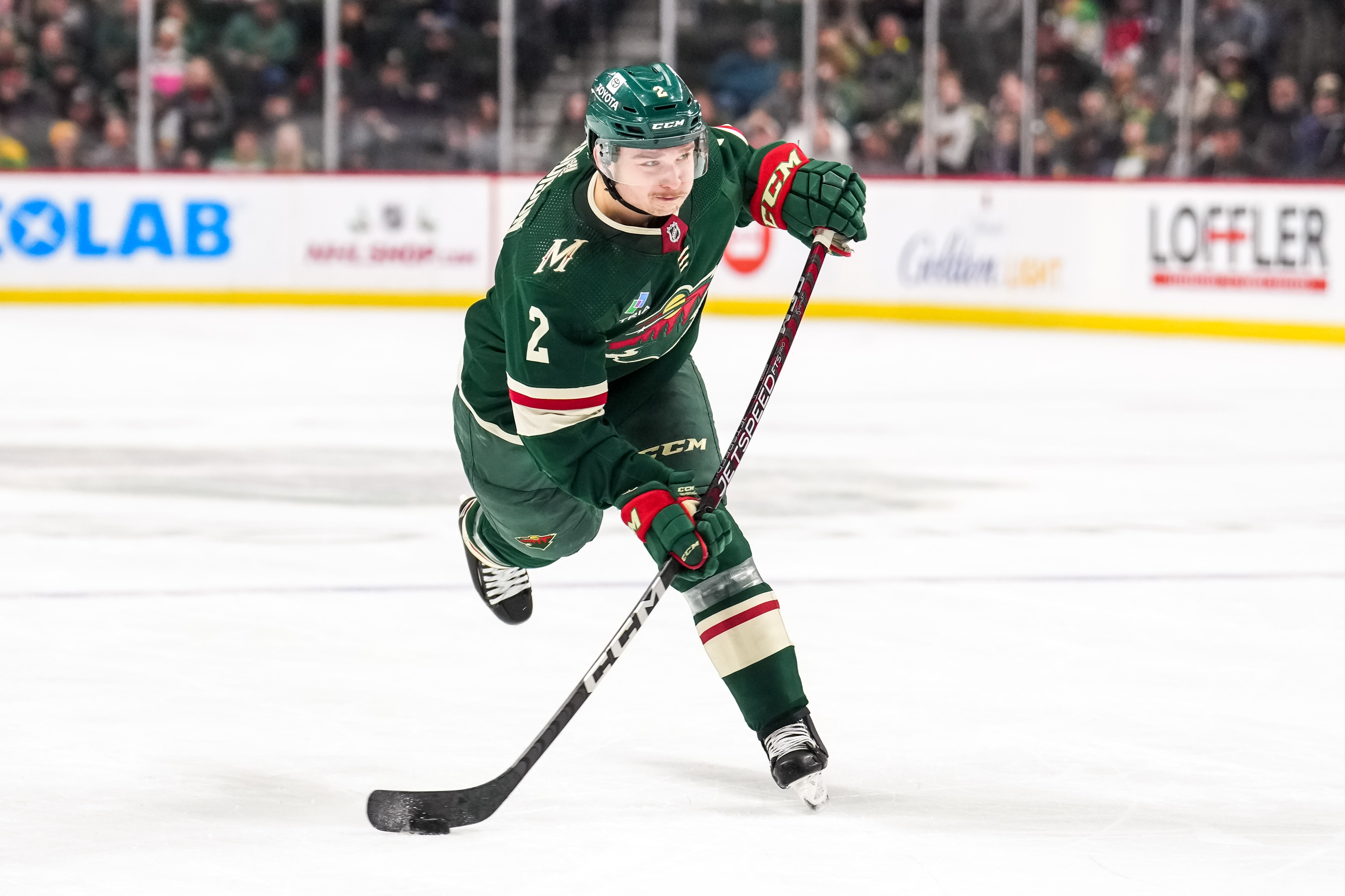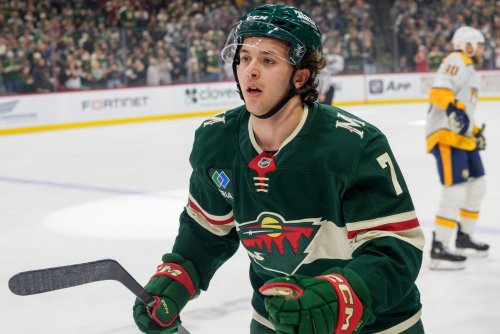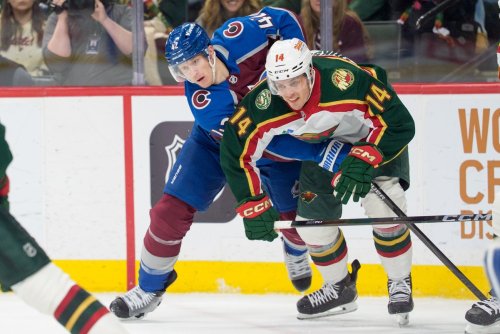
The power play is a gigantic sore spot for the Minnesota Wild throughout their recent playoff history. In their 2021 series against the Vegas Golden Knights, Kirill Kaprizov and Co. went 2-for-11 in their seven-game series. They got more calls the next year against the St. Louis Blues, but to little avail, going 4-for-24 in six games.
Add that all up, and Minnesota was clipping at a robust 6-for-35. That's 17%. As you can tell by the results, that's not going to cut it.
Is it any better this year? Yes and no. You can't say that the power play hasn't showed up. The Wild notched a goal on the man advantage in every game so far and is 4-17. 23% isn't lighting the world on fire, but that's better, right?
Right?
Eh. We've got to remember that goal-scoring is on the rise, so a 23% power play isn't exactly what it used to be. The Wild are ninth in the league in power play percentage, compared to last year, when they were... tenth. The year before that? Tied for ninth.
This parallels Minnesota's long-standing history of being pretty mediocre on the power play. With all the star players cycling through the organization -- your Zach Parises, Kaprizovs, Kevin Fialas, Matt Boldys, and a large group of name-brand defensemen -- the Wild have exactly one top-10 finish in power play rate in their last 13 years. That would be the 2019-20 season, and they finished tied for 10th.
For a bright moment, it looked like the Wild had the juice to crack the league's top-10, but they trailed off as the year drew to a close. Why? You can point to injuries with Kaprizov, but there's no denying one thing:
The Wild miss Calen Addison running the power play.
Well, maybe there is denying it. Addison has been firmly on the bench since the trade deadline, with only injuries and rest allowing him back in the lineup. Right now, he's nowhere close to drawing into the lineup, at least as far as we know. With Brock Faber's emergence, it'd be a shock to find out Addison is even the team's eighth defenseman on their internal depth chart.
To some extent, you get it. The Wild certainly don't miss Addison at 5-on-5. Like a young Matt Dumba, Addison's mistakes stand out on a blueline that prides itself on its discipline. His ghastly minus-17 in the regular season is more fueled by poor goaltending than anything else, but no one will sincerely argue he's an above-average defender.

But through four games, it's clear that the way Addison runs a power play outstrips anyone else in the organization. It sounds silly to point the finger at the power play, when the Wild's biggest concern is their suddenly-leaky penalty kill. But if Dallas is going to rain goals on Minnesota on the man advantage, they have to try and keep up.
John Klingberg isn't capable of that right now.
We get it, they're 23% on the series, and 2-for-8 since Klingberg came back and took over for Jared Spurgeon at the point. Klingberg has been a power play quarterback his entire career, and was a great one at his peak. We still haven't seen much time with him and Kaprizov, let alone a healthy version. There are a number of reasons you can throw out to absolve the power play.
But it isn't about assigning or deflecting blame, not in the playoffs. It's about winning. To do that, Minnesota has to be opportunistic, and they just haven't been that on the power play this series. Let's list the situations where the Wild scored their power play goals, and how much they increased their chances of winning:
Game 1: Kaprizov opened scoring; increased Minnesota's chances of winning 22.1%
Game 2: Marcus Johansson closes Dallas' lead to 5-2 in second period; increased Minnesota's chances of winning 5.9%
Game 3: Marcus Foligno (second unit) notches insurance goal in second period to make it 3-1 Wild; odds of winning increase 18.9%
Game 4: Minnesota scores on 6-on-4 with 1:20 remaining in game to make it 3-2 Dallas; increased Minnesota's chances of winning 3.0%
Not surprisingly, the Wild won the two games where they scored timely power play goals, and they lost when they couldn't convert in high leverage opportunities.
The Wild went 1-for-4 on Sunday, but that is divorced from the leverage of those opportunities. They had an opportunity to break a scoreless game with a power play 12 minutes into the second period, then two more to tie the game at one to close the second period and open the third.
They failed. The first missed opportunity allowed Dallas to score the first goal of the game. Immediately after the end of their third failed power play, Evgenii Dadonov stepped out of the penalty box and put the game all but out-of-reach at 2-0.
The Wild only mustered four unblocked shot attempts with any sort of danger on those power plays. The two most dangerous were a missed net from Kaprizov, and a shot in close by Freddy Gaudreau on the second unit. The other two were a shot by Boldy and a missed shot by Kaprizov in the slot, both with only about an 8% chance of going in.
Rewatching those three power plays is an exercise in frustration, and Klingberg was often at the center of it. He twice failed to hold the zone on clearing attempts and mishandled a pass to see the puck leave the zone a third time. He only fired one shot, from the point, which was blocked like many-a Ryan Suter wrister from the days of old.
And the zone entries! He twice burned 11 valuable seconds off the clock with slow drop-passes to Johansson, allowing Stars penalty killers to get set. On the third power play, he and Johansson couldn't get into the zone for over half a minute.
On top of all that, Addison's quick-zip passing style was absent in favor of a slower, more methodical perimeter passing game. Wild fans have to remember better days and know they can have so much better.
Counting playoffs, the Wild are scoring just 5.25 goals per hour with Klingberg on the ice on the power play. Minnesota averaged a staggering 10.42 goals per hour with Addison manning the power play in the regular season. Klingberg's underlying numbers look better than his results, but his shots and expected goal rates trail Addison.
On the other side, Miro Heiskanen quarterbacked the Stars' power play to over 12 goals per hour. In a small sample size, he's doubled it in the playoffs. Minnesota's giving up too much to keep Addison off of the power play.
But it's not as simple as putting him in for Klingberg. Minnesota needs him at 5-on-5 play. For all his faults on the power play and in his own zone, Addison can lead the breakout and contribute offensively at even strength in a way few Wild defensemen can. We saw Klingberg's magic when he saved a goal at one end of the ice, then converted at the other seconds later to make the game 2-1.
But if you start Addison and Klingberg on defense, that's two pretty big defensive liabilities out on the blueline. So how do the Wild navigate this?
The answer: Go with an 11-forward, 7-defenseman lineup and use Addison purely as a power play specialist.
This goes against Evason's pointed comments to Addison about how the league is too good to be a specialist. That might be true long-term, but the Wild have needs right now. If they have to get a specialist to fulfill them, so be it.
Besides, it's not like the Wild don't have specialists as it is. Connor Dewar and Ryan Reaves take a semi-regular 5-on-5 shift, but what are they to this team but specialists at the moment? Dewar is in the lineup almost purely for his penalty-killing abilities. Reaves is in there almost purely for his physicality.
What's the harm in hiding a third specialist on that fourth-line in Addison? In crunch time, they can double-shift players like Kaprizov, Boldy, or even Gustav Nyquist, who deserves more minutes than he currently is getting in his role.
The gap in Addison's ability to run a power play against the rest of the team's defensemen is greater than any marginal benefit they'd lose in not playing Sam Steel or Oskar Sundqvist at 5-on-5. Evason can hide Addison to his heart's content while keeping him fresh enough to have a rhythm on the power play. Perhaps it's not ideal, but they need more goals than they're getting now.
Evason is a coach who is very much set in his ways, and it's hard to imagine him letting Addison out of the doghouse with the season on the line. But doing so would be the kind of... if not overly creative, then certainly necessary adjustment that he didn't make until it was too late last season. Like it or not, they need what Addison can bring.
Think you could write a story like this? Hockey Wilderness wants you to develop your voice, find an audience, and we'll pay you to do it. Just fill out this form.








Recommended Comments
Join the conversation
You can post now and register later. If you have an account, sign in now to post with your account.
Note: Your post will require moderator approval before it will be visible.